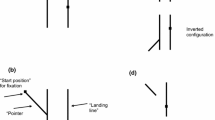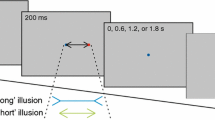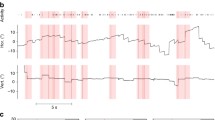Abstract
Using spatially identical displays (variants of the Müller–Lyer illusion), we compared the accuracy of spatial verbal judgments with that of saccadic (eye) and pointing (hand) movements. Verbal judgments showed a clear effect of the illusion. The amplitude of the primary saccade from one endpoint of the pattern (at fixation) to the other also showed an effect of the illusion. Conversely, movement amplitudes when pointing from one endpoint (initial finger position) to the other were significantly more accurate than both saccades and verbal responses. In a control experiment in which the viewing conditions between the saccade and pointing experiments were equalized, saccade amplitude was again affected by the illusion. In several studies, systematic biases in conscious spatial judgments have been contrasted with accurate open-loop pointing in peripersonal space. It has been proposed that such seeming dissociations between vision-for-action and vision-for-consciousness might in fact be because of a simple oculomotor strategy: saccade to the target before it disappears, then use the efference copy of the (accurate) saccadic movement to drive pointing. The present data do not support the hypothesis in this simple form.





Similar content being viewed by others
References
Abrams RA (1994) Eye hand coordination: spatial localization after saccadic and pursuit eye movements. J Motor Behav 26:215–224
Bahill AT, Adler D, Stark L (1975) Most naturally occurring human saccades have magnitudes of 15 degrees or less. Invest Ophthalmol Vis Sci 14:468–469
Bekkering H, Abrams RA, Pratt J (1995) Transfer of saccadic adaptation to the manual motor system. Hum Movement Sci 14:155–164
Binsted G, Elliott D (1999a) The Müller–Lyer illusion as a perturbation to the saccadic system. Hum Movement Sci 18:103–117
Binsted G, Elliott D (1999b) Ocular perturbation and retinal/extraretinal information: the coordination of saccadic and manual movements. Exp Brain Res 127:193–206
Bruno A, Crespi S, Morrone CM (2003) Saccadic adaptation influences pointing localisation of transient stimuli. In: European Conference on Visual Perception, vol 32, Pion, Paris
Bruno N (2001) When does action resist visual illusions? Trends Cognit Sci 5:385–388
Bruno N, Bernardis P (2002) Dissociating perception and action in Kanizsa’s compression illusion. Psychon Bull Rev 9:723–730
Bruno N, Bernardis P (2003) When does action resist visual illusions? Effector position modulates illusory influences on motor responses. Exp Brain Res 151:225–237
Burr DC, Morrone MC, Ross J (2001) Separate visual representation for perception and action revealed by saccadic eye movements. Curr Biol 11:798–802
Carey DP (2000) Eye–hand coordination: hand to eye or eye to hand? Curr Biol 10: R416–R419
Carey DP (2001) Do action systems resist visual illusions? Trends Cognit Sci 5:109–113
de Graaf JB, Pelisson D, Prablanc C, Goffart L (1995) Modifications in end positions of arm movements following short term saccadic adaptation. Neuroreport 6:1733–1736
Desmurget M, Grafton S (2000) Forward modelling allows feedback control for fast reaching movements. Trends Cognit Sci 4:423–431
Deubel H (1995) Separate adaptive mechanisms for the control of reactive and volitional saccadic eye movements. Vis Res 35:3529–3540
Festinger L, Canon LK (1965) Information about spatial location based on knowledge about efference. Psychol Rev 5: 373–384
Franz VH (2001) Action does not resist visual illusions. Trends Cognit Sci 5:457–459
Franz VH, Fahle M, Bulthoff HH, Gegenfurtner KR (2001) Effects of visual illusion on grasping. J Exp Psychol Hum 27:1124–1144
Franz VH, Gegenfurtner KR, Bulthoff HH, Fahle M (2000) Grasping visual illusions: no evidence for a dissociation between perception and action. Psychol Sci 11:20–25
Gentilucci M, Chieffi S, Daprati E, Saetti MC, Toni I (1996) Visual illusion and action. Neuropsychologia 34:369–376
Gentilucci M, Daprati E, Saetti MC, Toni I (1997) On the role of the egocentric and allocentric frame of reference in the control of arm movement. In: Karnath O, Thier P (eds) Parietal lobe contribution to orientation in 3D space. pp 339–354
Glover SR, Dixon P (2001) Dynamic illusion effects in a reaching task: Evidence for separate visual representations in the planning and control of reaching. J Exp Psychol Hum 27:560–572
Glover SR, Dixon P (2002) Dynamic effects of the Ebbinghaus illusion in grasping: support for a planning/control model of action. Percept Psychophys 64:266–278
Hansen RM (1979) Spatial localization during pursuit eye movements. Vis Res 19:1213–1221
Henriques DYP, Klier EM, Smith MA, Lowy D, Crawford JD (1998) Gaze-centered remapping of remembered visual space in an open-loop pointing task. J Neurosci 18:1583–1594
Mack A, Heuer F, Villardi K, Chambers D (1985) The dissociation of position and extent in Mueller–Lyer figures. Percept Psychophys 37:335–344
McCarley JS, Kramer AF, DiGirolamo GJ (2003). Differential effects of the Müller–Lyer illusion on reflexive and voluntary saccades. J Vision 3:751–760
McLaughlin SC (1967) Parametric adjustment in saccadic eye movement. Percept Psychophys 2:359–362
Meegan DV, Glazebrook CM, Dhillon VP, Tremblay L, Welsh TN, Elliott D (2004) The Müller–Lyer illusion affects the planning and control of manual aiming movements. Exp Brain Res 155:37–47
Miall RC, Wolpert DM (1996) Forward models for physiological motor control. Neural Networks 9:1265–1279
Milner AD, Dyde R (2003) Why do some perceptual illusions affect visually guided action, when others don’t? Trends Cognit Sci 7:10–11
Milner AD, Goodale MA (1995) The visual brain in action. University Press, Oxford
Munoz DP (2002) Commentary: saccadic eye movements: overview of neural circuitry. Prog Brain Res 140:3–19
Post RB, Welch RB (1996) Is there dissociation of perceptual and motor responses to figural illusions? Perception 25:569–581
Smeets JBJ, Brenner E (1995) Perception and action are based on the same visual information: distinction between position and velocity. J Exp Psychol Hum 21:19–31
Soechting JF, Engel KC, Flanders M (2001) The Duncker illusion and eye-hand coordination. J Neurophysiol 85:843–854
Tipper PS, Howard AL, Paul MA (2001) Reaching affects saccade trajectories. Exp Brain Res 136:241–249
Vishton PM, Rea JG, Cutting JE, Nunez LN (1999) Comparing effects of the horizontal-vertical illusion on grip scaling and judgment: relative vs. absolute, not perception vs. action. J Exp Psychol Human 25:1659–1672
Wraga M, Creem SH, Proffitt DR (2000) Perception-action dissociations of a walkable Müller–Lyer configuration. Psychol Sci 11:239–243
Acknowledgements
Supported by the Wellcome Trust (PK) and by the University of Trieste (PB and NB). The authors wish to thank two anonymous referees and David Carey for their comments, and all the naïve volunteers (especially Jillian and Ian, who participated in the tedious oculomotor measurements) for their time. We are also grateful to an anonymous referee for suggesting Experiment 4.
Author information
Authors and Affiliations
Corresponding author
Rights and permissions
About this article
Cite this article
Bernardis, P., Knox, P. & Bruno, N. How does action resist visual illusion? Uncorrected oculomotor information does not account for accurate pointing in peripersonal space. Exp Brain Res 162, 133–144 (2005). https://doi.org/10.1007/s00221-004-2121-9
Received:
Accepted:
Published:
Issue Date:
DOI: https://doi.org/10.1007/s00221-004-2121-9




